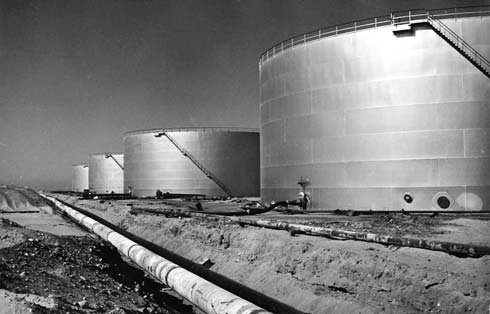
Should we believe in miracles? The day to day happenings in our world make this difficult for the majority of people. But what has oil got to do with miracles, you will ask? Hope, in certain quarters, is never lost that somewhere beneath the hills and planes, the ravines and seas of our small country the black gold lies waiting to be discovered and to bring riches. How can it be that neighboring countries around us have numerous oilfields producing both oil and gas but alas we have so far discovered only traces and minimal amounts? Since the 40s approximately 410 petroleum wells have been drilled in Israel – results have been varied but not exciting. The Heletz oilfield south of Ashkelon was the first to go into production and then the Zohar gas field was discovered in the north-east corner of the Negev. Conclusions were eventually reached that drilling would have to be made into deeper seismic strata in order to obtain results.
Following the take over of Sinai in 1967, the government reduced its financial support for local geological studies and surveys as well as for actual continued exploration. And why? Because there was oil in Sinai and Israel had the Abu Rudeis oil fields under its control. A national company – Netevei Neft – was established and they continued the work together with the Italian Oil Company AGIP who had been partners with Egypt. Now efforts were focused on these Gulf of Suez fields.
Let me take you back in time; you will find little mention on the Internet or in available literature of those years 1967 to 1975 when almost 65% of national oil requirements came from those fields. In fact many younger generations have no knowledge of that period in time when we really learnt what oil rigs, platforms and oil production was all about. Sleeves were rolled up, workers were employed, experts brought in from abroad and the task of reinstating and improving production went into action.
The takeover was successful and production output was improved as the Israeli teams learnt the job and more wells were drilled and consequently went into production. The base camp and its facilities were upgraded in order to assist with working patterns and to become economically more efficient, it was decided to partially move away from the crew rotation system and provide family accommodation in Abu Rudeis. Down the desert road, away from the wells, storage tanks and drilling sites, a small village came into existence with a preschool nursery and infant classes. Life fell into a pattern and Israelis once again proved that when they rolled up their sleeves the job could be done. Camp life continued with its human pattern of work and relaxation, hopes and aspirations, relationships and ties with the expatriates and eventually led to the entry of Israelis into the international oil scene.
October 6, 1973 and for those families waking up to Yom Kippur (the Day of Atonement) in Abu Rudeis, a shock awaited. War with all its terrifying implications was on the doorstep. Wells were closed down and evacuation began, deciding who would stay on to work and to fight and who would get on a flight to the north with their family.
Post-war, the fields went back into production, war damages were put aright but the families never returned and the village lay empty. Eventually in 1975 the fields were returned to the Egyptians; however the southernmost part of Sinai was still in Israeli hands and the oil price crisis of that year renewed the Israeli efforts to discover more oil. Oil shows were found in lower Jurassic limestone levels north of Jerusalem and other seismic levels were probed in the northern Negev. However, a large effort was put into drilling on the coast of southern Sinai where geological surveys had been promising and resulted in the establishment of the Alma oilfield. Investment and management were provided by an American company and in a short time a party was thrown in Tel Aviv to celebrate the results which produced wells whose future output was valued at one hundred billion dollars, and the achievement of a world record for the time taken from discovery till production.
But 1979 the furthering of the peace agreement with Sadat saw the final exit of the Israelis from the Sinai oil scene and the Alma field was also returned to the Egyptians. Now what we are left with are hopes and the continued drilling of exploration wells by companies such as Zion Oil, funded by American evangelists and carried out on lands at Kibbutz Maanit and Ginko Company with Lapidot, sweating it out in the area of the Dead Sea where a renewed drilling operation in 2006 brought oil spurting up from a depth of some 1,800 meters and lit hopes for the fulfillment of the dream. Also in the region of Rosh Ha'Ayin expectations were high and the company Givot Olam expressed their belief that exploration drilling being carried out in a number of areas there would produce profitable results. In 2004 they obtained a production lease for the Meged oilfield on an area of 243 kilometers near Kfar Saba and still holding high hopes and issuing a prophesy for potentially the largest oil field in Israel. Our old-timer Heletz-Lapidot continues to pump away and produce an average of up to thirty barrels per day. Offshore gas production has been more rewarding with Isramco and Avner Oil and Gas managing to provide some gas for home consumption.
Plans and hopes exist as does conviction for those Christian believers such as Haywood Stevens of "Ness Energy" who claims that G-d originally intended the oil to be the basis of Israel's future riches; however, he became angry with the evil that existed and thus he caused the Dead Sea fault to move, resulting in the ignition of the oil and its explosion – see Sodom and Gomorrah. The intensity of the heat converted the rock to salt but there under the salt plug the black gold still waits to be found. Closing on an optimistic note, I will quote the words of one believer "In the Bible God has told us exactly where oil can be found in Israel. See Deut.33;24. Oil is in the foot of Asher, not in the toes or ankles but in the FOOT. I love the dear Jewish people and I pray for them that G-d will continue to overshadow them and keep them safe and supply all their needs."
And so say all of us.
Photo Captions:-
1. Farewell Abu Rudeis – lowering the Israeli Flag November 1975
2. The Handover – 1975
3. This is a shot post 1967 war when we took over Sinai and the oil fields
4. The oil storage tanks renewed by Israel post devastation of 1967 war
 The Bereavement & Loss Program
The Bereavement & Loss Program Thank You Eddie
Thank You Eddie Save One Life, Save A World
Save One Life, Save A World A new website in English - on Volunteering - Launched in Israel
A new website in English - on Volunteering - Launched in Israel Help Needed for Abused Horses and Donkeys
Help Needed for Abused Horses and Donkeys Heather's Heseg
Heather's Heseg Barbara Abraham
Barbara Abraham